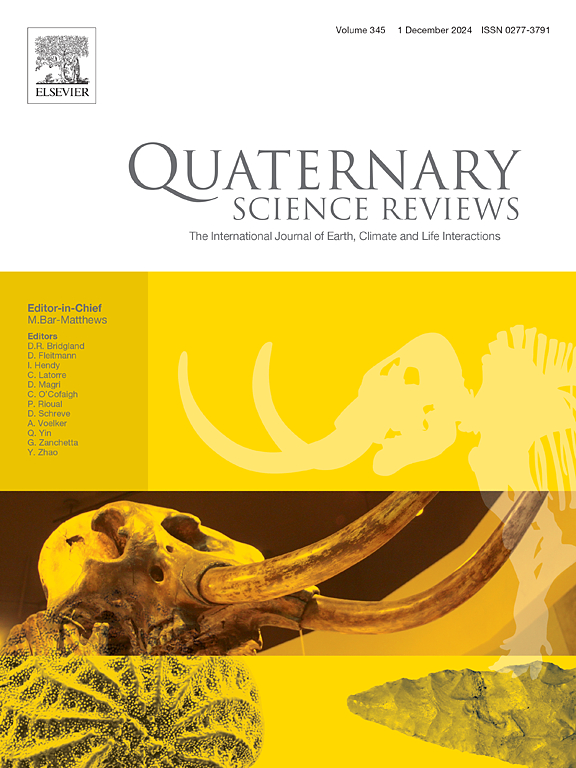南非南部近海古阿古拉斯平原沉积物中记录的末次消冰期以来的交替海侵
IF 3.2
1区 地球科学
Q1 GEOGRAPHY, PHYSICAL
引用次数: 0
摘要
南非南部海岸的古海洋学条件受到大西洋和印度洋之间的大气和海洋学相互作用的影响,尽管很少有研究表明,自上次消冰以来,这些条件在一次主要的海洋-陆地海侵的影响下是如何变化的。为了更好地了解南非南部海岸的古海洋和古环境变化及其驱动机制,在GeoB20628-1海洋沉积物岩心中研究了有机壁鞭毛藻囊(dinocysts),并发表了包括花粉和孢子、微炭、有孔虫有机衬里和甲壳类附属物在内的多代理数据。结果表明,在海侵、河流输入、上升流强度及其与区域植被和气候变化的相互作用下,近14ka沉积环境发生了明显的变化。统计分析表明,三种不同类型恐龙囊群占主导地位的带依次出现。自养类群(类群1),如centrrocarpum、tuberlodinium vanampoae和Spiniferites等产生的高频率藻囊表明,在最后一次冰川消退期间,低海平面林分存在泻湖环境。在随后过渡到全新世期间,异养分类群(第2组),包括Brigantedinium spp.、Echinidinium spp.、Protoperidinium monoospinum的最大值与强河流排放相关的养分输入一致。第2组在全新世被其他异养分类群(第3组)所取代。在热带东风增强的影响下,紫棘球绦虫、针叶棘球绦虫和透明棘球绦虫表现出典型的凉爽、富营养化和上升流活跃的水体特征。本文章由计算机程序翻译,如有差异,请以英文原文为准。
Alternating marine-terrestrial transgression since the last deglaciation recorded in sediments from the Palaeo-Agulhas Plain offshore southern South Africa
Palaeoceanographic conditions along the southern coast of South Africa are impacted by atmospheric and oceanographic interactions between the Atlantic and Indian Oceans, although there have been rather few studies of how these conditions have varied since the last deglaciation under the influence of a major marine-terrestrial transgression. In order to better understand palaeoceanographic and palaeoenvironmental changes and their driving mechanisms offshore the southern coast of South Africa, organic-walled dinoflagellate cysts (dinocysts) have been investigated in marine sediment core GeoB20628-1 along with published multiproxy data including pollen and spores, microcharcoal, foraminiferal organic linings and crustacean appendages. The results reveal markedly distinct changes in the depositional environment over the last 14 ka driven by the interplay of marine transgression, fluvial input, upwelling intensity and their interactions with regional vegetation and climate changes. Statistical analysis indicates the sequential occurrence of three distinct zones dominated by different dinocyst groups. High frequencies of dinocysts produced by autotrophic taxa (Group 1), such as Operculodinium centrocarpum, Tuberculodinium vancampoae and Spiniferites spp. signals the existence of a lagoonal environment during a low sea level stand during the last deglaciation. During the subsequent transition to the Holocene, maximum values of heterotrophic taxa (Group 2), including Brigantedinium spp., Echinidinium spp., Protoperidinium monospinum, are consistent with input of nutrients associated with strong river discharge. Group 2 was then replaced in the Holocene by other heterotrophic taxa (Group 3). Selenopemphix quanta, Echinidinium aculeatum and Echinidinium transparantum, indicate characteristically cool and nutrient-rich waters with active upwelling under the influence of strengthened tropical easterlies.
求助全文
通过发布文献求助,成功后即可免费获取论文全文。
去求助
来源期刊

Quaternary Science Reviews
地学-地球科学综合
CiteScore
7.50
自引率
15.00%
发文量
388
审稿时长
3 months
期刊介绍:
Quaternary Science Reviews caters for all aspects of Quaternary science, and includes, for example, geology, geomorphology, geography, archaeology, soil science, palaeobotany, palaeontology, palaeoclimatology and the full range of applicable dating methods. The dividing line between what constitutes the review paper and one which contains new original data is not easy to establish, so QSR also publishes papers with new data especially if these perform a review function. All the Quaternary sciences are changing rapidly and subject to re-evaluation as the pace of discovery quickens; thus the diverse but comprehensive role of Quaternary Science Reviews keeps readers abreast of the wider issues relating to new developments in the field.
 求助内容:
求助内容: 应助结果提醒方式:
应助结果提醒方式:


